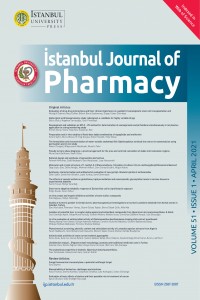Abstract
Background and Aims: Alpha lipoic acid 600 mg HR film tablet showed high intra-subject variabilities in bioequivalence studies. In this regard, this study aims to determine whether Alpha lipoic acid 600 mg HR film coated tablet is a highly variable drug. Methods: First, a randomized, open-label, balanced, two-treatment, two-period, two-sequence, single-dose, two-way crossover oral bioequivalence study comparing the test product (Alpha lipoic acid HR film tablet - ILKO Pharmaceuticals, Turkey) with the reference product (Thioctacid®- Meda Pharma, Germany) was conducted in normal, healthy, adult human subjects under fasting conditions (Study 1). Secondly, a randomized, open-label, balanced, two-treatment, four-period, two-sequence, single-dose, fully replicate crossover oral bioequivalence study was conducted in normal, healthy, adult human subjects under fasting conditions (Study 2). Results: Study 1 failed. It had a 90% confidence interval for LnCmax (ng/mL) value between 79.69% – 138.98% with a high intra-subject coefficient of variability (ISCV=57.5%). In study 2 a 90% confidence interval for LnCmax (ng/mL) was found between 88.40% – 129.81% while the ISCV value for LnCmax was 64.5%. Conclusion: The findings suggest that bioequivalence study for Alpha lipoic acid HR film tablet should be redesigned since this is a highly variable drug. Therefore, conventional bioequivalence acceptable limits (80.0%-125.0%) should be adjusted to 69.84% – 143.19% for alpha lipoic acid.
Keywords
Alpha lipoic acid bioequivalence highly variable drugs intra-subject variability replicate design
References
- Amenta, F., Traini, E., Tomassoni, D., & Mignini, F. (2008). Pharmacokinetics of different formulations of tioctic (alpha-lipoic) acid in healthy volunteers. Clinical and Experimental Hypertension, 30(8), 767–775. https://doi.org/10.1080/10641960802563568
- • Blume, H., Zhong, D., Elze, M., Wendt, G., Schug, B., Scheidel, B. … Hagenlocher, M. (1994). Advantages of a steady-state crossover design in assessment of bioequivalence of highly variable drugs: propafenone. European Journal of Pharmaceutical Sciences, 2(5-6), 385-393. https://doi.org/10.1016/0928-0987(94)00068-9
- • Brufani, M., & Figliola, R. (2014). (R)-α-lipoic acid oral liquid formulation: pharmacokinetic parameters and therapeutic efficacy. Acta Bio-Medica: Atenei Parmensis, 85(2), 108-115. Retrieved from https://www.mattioli1885journals.com/index.php/actabiomedica/ article/view/3800
- • Fagiolino, P., González, N., Vázquez, M., & Eiraldi, R. (2007). Itraconazole Bioequivalence Revisited: Influence of Gender on Highly Variable Drugs. The Open Drug Metabolism Journal, 1, 7-13. http:// dx.doi.org/10.2174/1874073100701010007
- • Ghelani, H., Razmovski-Naumovski, V., & Nammi, S. (2017). Chronic treatment of (R)-a-lipoic acid reduces blood glucose and lipid levels in high-fat diet and low-dose streptozotocin-induced metabolic syndrome and type 2 diabetes in Sprague-Dawley rats. Pharmacology Research & Perspectives, 5(3). https://doi. org/10.1002/prp2.306
- • Helmy, S. A., & El Bedaiwy, H. M. (2013). Comparative in vitro dissolution and in vivo bioavailability of diflunisal/naproxen fixeddose combination tablets and concomitant administration of diflunisal and naproxen in healthy adult subjects. Drug Research, 63(3), 150–158. http://dx.doi.org/10.1055/s-0033-1333768
- • Kang, Q., & Vahl, C. I. (2017). Testing for bioequivalence of highly variable drugs from TR‐RT crossover designs with heterogeneous residual variances. Pharmaceutical Statistics, 16(5), 361–377. http://doi.org/10.1002/pst.1816
- • Keith, D. J., Butler, J. A., Bemer, B., Dixon, B., Johnson, S., Garrard, M. … Hagen, T. M. (2012). Age and gender dependent bioavailability of R- and R,S-α-lipoic acid: A pilot study. Pharmacological Research, 66(3), 199–206. http://doi.org/10.1016/j.phrs.2012.05.002
- • Knahl, S. I., Lang, B., Fleischer, F., & Kieser, M. (2018). A comparison of group sequential and fixed sample size designs for bioequivalence trials with highly variable drugs. European Journal of Clinical Pharmacology, 74(5), 549–559. https://doi.org/10.1007/s00228- 018-2415-7
- • Li, C., Xu, J., Zheng, Y., Chen, G., Wang, J., Ma, L. … Ding, Y. (2017). Bioequivalence and Pharmacokinetic Profiles of Agomelatine 25-mg Tablets in Healthy Chinese Subjects: A Four-Way Replicate Crossover Study Demonstrating High Intra- and Inter-Individual Variations. Chemical & Pharmaceutical Bulletin, 65(6), 524- 529. https://doi.org/10.1248/cpb.c16-00866
- • Lohar, V., Patel, H., Rathore, A. S., Singhal, S., Sharma, A. K., & Sharma, P. (2012). Bioequivalence and highly variable drugs: an overview. International Journal of Current Research and Review, 04(08), 124- 146. Retrieved from https://www.ijcrr.com/uploads/1853_pdf.pdf
- • Mignini, F., Streccioni, V., Tomassoni, D., Traini, E., & Amenta, F. (2007). Comparative Crossover, Randomized, Open-Label Bioequivalence Study on the Bioequivalence of Two Formulations of Thioctic Acid in Healthy Volunteers. Clinical and Experimental Hypertension, 29(8), 575-586. http://dx.doi. org/10.1080/10641960701744111
- • Mignini, F., Nasuti, C., Gioventu, G., Napolioni, V., & Martino, P. D. (2012). Human Bioavailability and Pharmacokinetic Profile of Different Formulations Delivering Alpha Lipoic Acid. Open Access Scientific Reports, 1(8), 418. http://dx.doi.org/10.4172/scientificreports. 418
- • Molins, E., Cobo, E., & Ocaña, J. (2017). Two‐stage designs versus European scaled average designs in bioequivalence studies for highly variable drugs: Which to choose? Statistics in Medicine, 36(30), 4777- 4788. https://doi.org/10.1002/sim.7452
- • Thota, S., Khan, S. M., Tippabhotla, S. K., Battula, R., Gadiko, C., & Vobalaboina, V. (2013). Bioequivalence of two lansoprazole delayed release capsules 30 mg in healthy male volunteers under fasting, fed and fasting-applesauce conditions: A partial replicate crossover study design to estimate the pharmacokinetics of highly variable drugs. Drug Research, 63(11), 551–557. http://dx.doi. org/10.1055/s-0033-1347236
- • US FDA Code of Federal Regulations. (2019, April). Title 21, Section 314.3 Definitions. Retrieved from https://www.accessdata. fda.gov/scripts/cdrh/cfdocs/cfcfr/CFRSearch.cfm?fr=314.3
Details
| Primary Language | English |
|---|---|
| Subjects | Pharmacology and Pharmaceutical Sciences, Health Care Administration |
| Journal Section | Original Article |
| Authors | |
| Publication Date | April 30, 2021 |
| Submission Date | March 9, 2020 |
| Published in Issue | Year 2021 Volume: 51 Issue: 1 |


